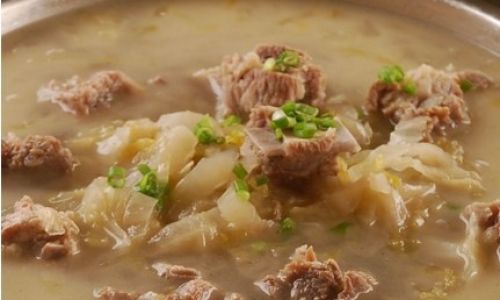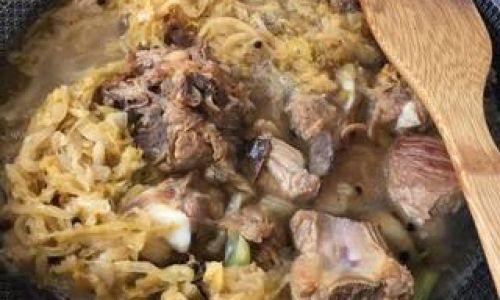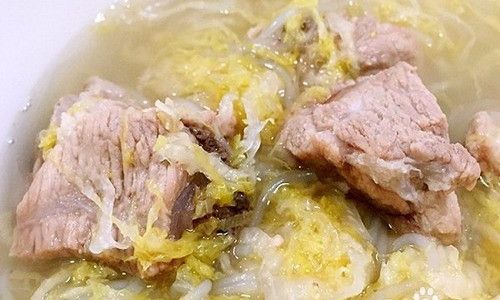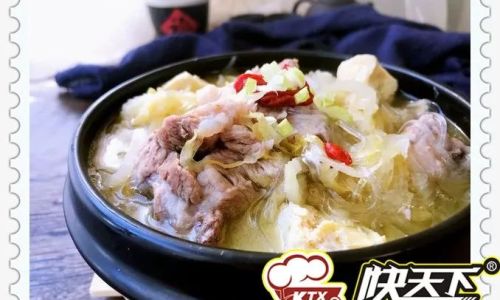Introduction
In the vast culinary landscape of global gastronomy, there exists a dish that harmoniously blends the flavors of earthiness and tanginess, warmth and freshness—Pork Ribs Stew with Sauerkraut. This hearty meal, often associated with Central and Eastern European cuisines, particularly those of Poland, Germany, and the Czech Republic, has transcended borders to become a beloved comfort food worldwide. Its appeal lies not only in its rich, savory taste but also in the simplicity of its preparation, allowing home cooks to create a restaurant-quality dish with minimal effort.
In this comprehensive guide, we will delve into the intricacies of making Pork Ribs Stew with Sauerkraut, from selecting the perfect ingredients to mastering the cooking process. By the end, you’ll be equipped with the knowledge and skills to craft a dish that is both nourishing and delightful, a perfect fusion of tender meat and tangy fermented vegetables.
Section 1: Ingredient Selection

The success of any culinary endeavor begins with the quality of its ingredients. When preparing Pork Ribs Stew with Sauerkraut, attention to detail in ingredient selection is crucial.
1 Pork Ribs
For this stew, you’ll need pork ribs, preferably baby back ribs or spare ribs. Baby back ribs are leaner and more tender, making them ideal for shorter cooking times. Spare ribs, on the other hand, offer more fat and connective tissue, resulting in a richer flavor and a more succulent texture after long, slow cooking. Choose ribs that are well-marbled and have a nice pink hue, indicating freshness.
2 Sauerkraut
Sauerkraut, the fermented cabbage that serves as the stew’s tangy backbone, should be well-fermented and not overly salty. Look for brands that use minimal additives and preservatives. Freshly made sauerkraut from local farmers’ markets or well-regarded brands can make a significant difference in the final taste.
3 Aromatics and Seasonings
The aromatic foundation of the stew includes onions, carrots, garlic, and bay leaves. These ingredients not only add depth to the broth but also help balance the acidity of the sauerkraut. Fresh herbs like thyme, rosemary, and parsley can be used for garnish to enhance the dish’s freshness.
For seasoning, salt and black pepper are essentials. You may also consider adding a pinch of caraway seeds, a traditional ingredient in Eastern European cooking that complements the sauerkraut beautifully.
4 Broth or Stock

A good quality broth or stock is vital for creating a flavorful base. Chicken or beef broth works well, but for an extra layer of richness, consider making your own bone broth.
5 Optional Ingredients
Feel free to experiment with additional ingredients such as potatoes, apples, or dried fruit like prunes, which can add sweetness and complexity to the stew.
Section 2: Preparation Techniques
With the ingredients in place, let’s move onto the preparation techniques that will ensure your Pork Ribs Stew with Sauerkraut is a success.
1 Preparing the Ribs
Begin by trimming any excess fat from the ribs. This not only helps reduce the final dish’s greasiness but also ensures a more balanced flavor. Season the ribs generously with salt and pepper on all sides.
2 Sautéing the Aromatics
In a large, heavy-bottomed pot or Dutch oven, heat a tablespoon of oil over medium heat. Add chopped onions and carrots, sautéing until they soften and begin to caramelize, about 5-7 minutes. Add minced garlic and cook for another minute until fragrant. This step creates a flavorful fond on the bottom of the pot, which will add to the stew’s depth.

3 Browning the Ribs
Remove the aromatics from the pot and set them aside. Increase the heat to medium-high and add a bit more oil if needed. Sear the ribs in batches, ensuring they are browned on all sides. This locks in juices and adds a layer of flavor to the broth. Once browned, remove the ribs and set them aside.
4 Building the Stew
Deglaze the pot with a splash of broth or white wine, scraping up the fond from the bottom. Return the aromatics to the pot, followed by the sauerkraut, bay leaves, and any optional ingredients you’ve chosen. Nestle the browned ribs into the mixture, ensuring they are partially submerged. Pour in enough broth to cover the ribs by about half. Bring the mixture to a simmer.
Section 3: Cooking Methods
The cooking method you choose will depend on your preference for texture and the amount of time you have available.
1 Stovetop Method
Reduce the heat to low, cover the pot, and let the stew simmer gently for about 2-3 hours, or until the ribs are tender and the sauerkraut has softened. Stir occasionally to prevent sticking and to ensure even cooking.
2 Oven Method

Alternatively, you can transfer the pot to a preheated oven at 325°F (165°C). Cook for about 2-3 hours, covered, until the ribs are tender. The oven’s consistent heat creates an even cooking environment, perfect for busy cooks who need to attend to other tasks.
3 Slow Cooker Method
For a hands-off approach, transfer the stew to a slow cooker. Cook on low for about 6-8 hours, or until the ribs are tender and falling off the bone. This method is ideal for those who want to prepare the dish in the morning and enjoy it later in the day.
Section 4: Finishing Touches
Once the ribs are tender and the sauerkraut has absorbed the flavors of the broth, it’s time to finish the stew.
1 Taste and Adjust Seasoning
Taste the stew and adjust the seasoning with salt and pepper as needed. Remember, sauerkraut can vary in saltiness, so taste frequently as you cook.
2 Thickening the Broth (Optional)
If you prefer a thicker broth, you can create a slurry by mixing a small amount of cornstarch or flour with water and stirring it into the stew during the last 30 minutes of cooking. Alternatively, remove some of the broth, let it cool slightly, then whisk in a small amount of cornstarch or flour before returning it to the pot.

3 Garnishing
Serve the stew hot, garnished with freshly chopped herbs like parsley, thyme, or rosemary. A dollop of sour cream or yogurt can add a refreshing creaminess, while a sprinkle of caraway seeds provides a hint of nutty flavor.
Section 5: Serving Suggestions
Pork Ribs Stew with Sauerkraut pairs beautifully with a variety of sides. Hearty options like mashed potatoes, rustic bread, or dumplings can soak up the rich broth. For a lighter touch, try serving it with a side of steamed vegetables or a crisp green salad.
Conclusion
Pork Ribs Stew with Sauerkraut is a dish that embodies the essence of comfort food. Its layers of flavor, from the tender, succulent ribs to the tangy, slightly sour sauerkraut, create a harmonious symphony on the palate. By following the steps outlined in this guide, you can bring this timeless classic into your kitchen, transforming simple ingredients into a meal that is both nourishing and soul-satisfying.
Remember, cooking is an art form that thrives on creativity and experimentation. Feel free to adapt this recipe to your taste preferences, whether it’s by adding different spices, incorporating new vegetables, or trying out various cooking methods. With each attempt, you’ll grow closer to mastering the art of Pork Ribs Stew with Sauerkraut, creating a dish that is uniquely yours.
Bon appétit!





0 comments